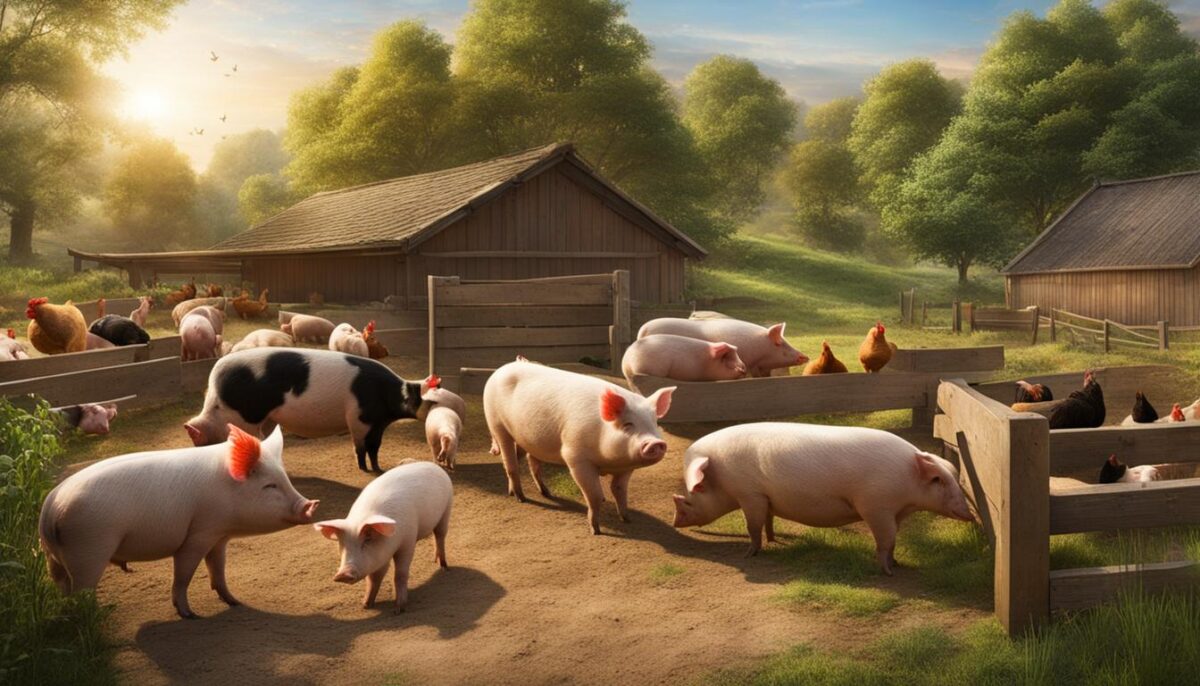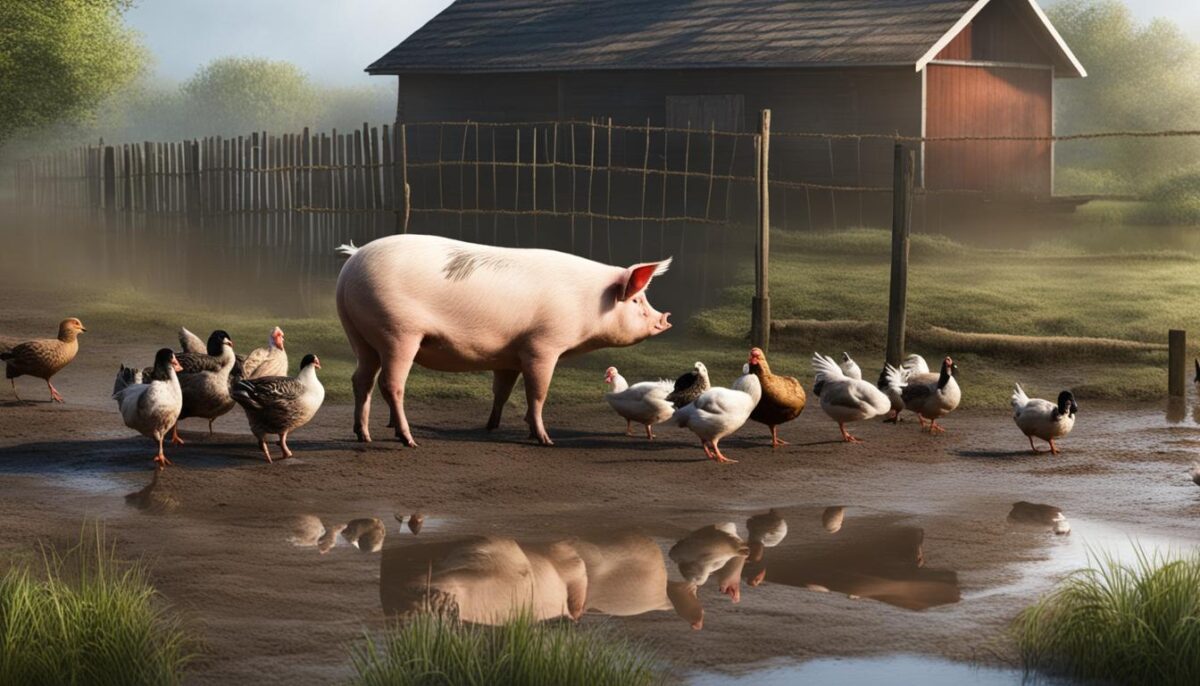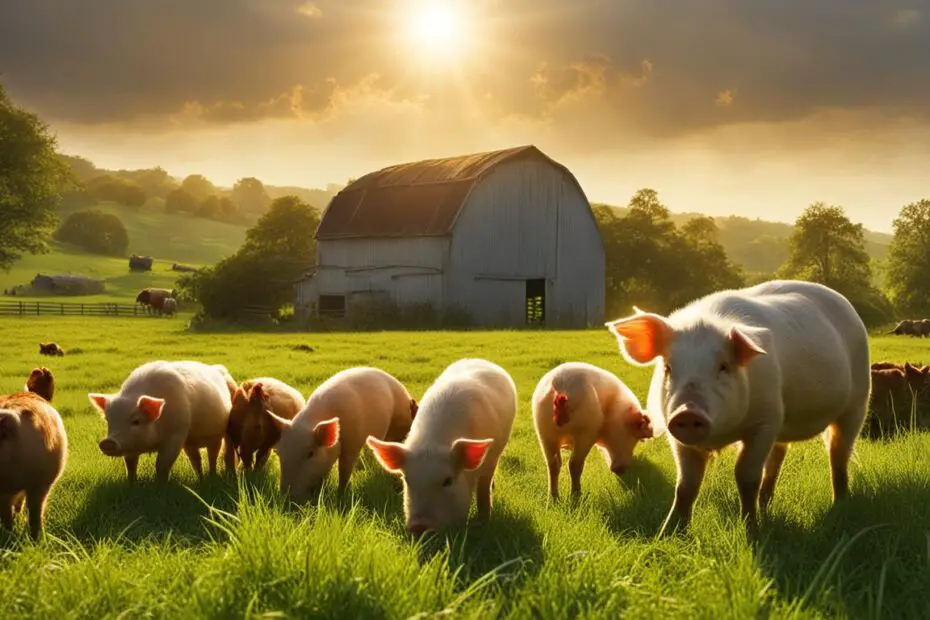When it comes to farm animals, pigs and chickens are often kept separate due to concerns about compatibility. However, contrary to common belief, these two species can actually live together harmoniously. Not only can they coexist peacefully, but they can also benefit from each other’s presence. Let’s delve into the truth about raising pigs and chickens together and explore the advantages of mixed farming.
Despite their differences in grazing and eating habits, pigs and chickens can form a mutually beneficial relationship. Chickens possess a natural ability to consume pests and parasites left behind by pigs, helping to control populations that can harm the health of both animals. In return, pigs aid in soil maintenance by turning it over with their rooting behavior, while also acting as a deterrent against potential predators.
Furthermore, combining pig and chicken farming can offer practical advantages. Raising these animals together can save space, making efficient use of available land. Additionally, it can reduce the workload associated with managing separate pig and chicken pens, as their cohabitation allows for shared resources and simplified daily chores.
While it is important to consider the specific needs of pigs and chickens to ensure their well-being, the compatibility of these animals can be successfully achieved with proper planning and management. Let’s explore the benefits, challenges, and best practices for raising pigs and chickens together:
Key Takeaways:
- Contrary to common belief, pigs and chickens can live together in harmony.
- Chickens can help control pests and parasites, while pigs contribute to soil maintenance and predator deterrence.
- Raising pigs and chickens together saves space and reduces workload.
- Separate feeding and egg collection areas are essential to prevent interference.
- Adequate space, breed selection, and early introduction are keys to minimizing aggression.
The Benefits of Raising Pigs and Chickens Together
When it comes to raising pigs and chickens together, there are several benefits that come along with this mixed farming practice. Firstly, these two species have different grazing habits and eating preferences, allowing them to complement each other’s needs. Chickens can help control pests and parasites that pigs may leave behind, while pigs can assist in tilling the soil and deterring potential predators.
Another advantage of raising pigs and chickens together is the enhanced utilization of pasture. Pigs root up the soil, exposing grubs and insects for the chickens to enjoy as a natural food source. This symbiotic relationship not only reduces the need for artificial pest control, but it also ensures that both animals have access to a diverse and nutritious diet.
Furthermore, the presence of pigs can offer additional protection for the chickens. Pigs are known to deter predators, acting as a natural defense system for the flock. With their strong sense of smell and ability to sound the alarm, pigs can help keep potential threats at bay, providing a safer environment for both pigs and chickens alike.
Table: Benefits of Raising Pigs and Chickens Together
| Benefit | Description |
|---|---|
| Pest Control | Chickens eat pests and parasites that pigs leave behind, reducing the need for chemical control methods. |
| Soil Improvement | Pigs help till the soil, promoting aeration and nutrient distribution. |
| Predator Deterrence | The presence of pigs helps deter potential predators, providing added protection for the chickens. |
| Improved Diet | Pigs and chickens have different dietary needs, allowing for a diverse and balanced diet when raised together. |
| Space Efficiency | Raising pigs and chickens together can save space and reduce the need for separate housing structures. |
Overall, the benefits of raising pigs and chickens together are numerous. From pest control and soil improvement to predator deterrence and improved diet, these two species can thrive in a harmonious coexistence. However, it is important to plan and manage their housing and feeding arrangements properly to ensure the well-being of both animals. With proper care and attention, raising pigs and chickens together can be a mutually beneficial practice for farmers.
Planning and Preparing for Pigs and Chickens
When it comes to housing pigs and chickens together, careful planning and preparation are essential for a successful cohabitation. Here are some tips for managing pigs and chickens together:
- Separate Feeding Areas: Designate separate areas for feeding pigs and collecting eggs from chickens. This helps prevent pig interference and ensures that pigs cannot access chicken feed and eggs.
- Electric Fencing and Automatic Doors: Install electric fencing to create restricted areas and prevent pigs from entering chicken coops. Automatic doors for chicken coops can also help control access and keep pigs out of restricted spaces.
- Ample Space and Environmental Enrichment: Provide ample space for both pigs and chickens to roam and explore. This prevents boredom and potential aggression towards chickens. Additionally, environmental enrichment, such as toys and structures, can help keep pigs mentally stimulated.
By implementing these measures, you can create a harmonious living environment for pigs and chickens, ensuring their well-being and compatibility.

Overall, pigs and chickens can coexist and thrive when given the right conditions and management. The key is to establish separate feeding areas, utilize proper fencing and doors to control access, and provide ample space and environmental enrichment for both species. By following these tips, you can successfully manage pigs and chickens together, enjoying the benefits of their symbiotic relationship and saving space in your farm or backyard.
Disease Risks and Prevention
Disease transfer between pigs and chickens is a concern when raising these animals together. While uncommon, it is crucial to take precautions to minimize the risk of disease transmission. Preventing disease transfer is essential for the overall health and well-being of both pigs and chickens.
Preventing Disease Transfer
One of the key measures to prevent disease transfer is to avoid allowing chickens to graze with medicated or dewormed pigs. The chemicals used in medication and deworming can have adverse effects on chickens and their eggs. It is also important to maintain adequate space between pigs and chickens to minimize close contact and reduce the risk of disease transmission.
Proper sanitation practices play a vital role in preventing the spread of diseases. Regularly clean and disinfect pig and chicken housing areas to eliminate pathogens. Providing a larger area for animals to roam can help spread out the manure load, reducing the concentration of pathogens in one area.
“Preventing disease transfer between pigs and chickens requires careful management and hygiene practices. By maintaining separate feeding and grazing areas, avoiding medicated or dewormed pigs grazing with chickens, and practicing proper sanitation, the risk of disease transmission can be significantly reduced.”
Disease Risk Assessment
Regular veterinary monitoring and disease risk assessments are crucial for early detection and prevention of diseases that can affect both pigs and chickens. Working closely with a veterinarian experienced in mixed farming can help identify potential disease risks and develop effective prevention strategies.
Regularly inspect pigs and chickens for any signs of illness, such as changes in behavior, appetite, or appearance. Promptly isolate and treat any sick animals to prevent the spread of disease within the population. Implementing biosecurity measures, such as restricting access to the farm and practicing proper hygiene protocols, can further reduce the risk of disease introduction.
| Disease Prevention Measures | |
|---|---|
| 1. | Separate feeding and grazing areas for pigs and chickens. |
| 2. | Avoid medicated or dewormed pigs grazing with chickens. |
| 3. | Maintain proper sanitation and hygiene practices. |
| 4. | Regular veterinary monitoring and disease risk assessments. |
| 5. | Implement biosecurity measures to prevent disease introduction. |
By implementing these disease prevention measures and staying vigilant in monitoring the health of pigs and chickens, the risk of disease transfer can be significantly minimized, allowing for a successful and harmonious cohabitation between these animals.
Overcoming Aggression and Compatibility
When housing pigs and chickens together, it is important to address the potential for aggression and ensure compatibility between the two species. While pigs and chickens can coexist harmoniously, certain measures should be taken to prevent any conflicts that may arise.
Preventing Aggression
Aggression between pigs and chickens can often be avoided by providing adequate space and ensuring that neither animal feels cornered. Most aggression occurs when one animal feels threatened or trapped. By providing sufficient foraging space and allowing both pigs and chickens to roam freely, the likelihood of aggression can be significantly reduced.
Breed Considerations
It is also important to consider the breed of the pig when housing them with chickens. Some pig breeds are inherently more docile and less likely to display aggressive behaviors. Choosing a breed known for its calm temperament can help facilitate a more peaceful cohabitation between pigs and chickens.
Introducing Animals at a Young Age
Introducing pigs and chickens at a young age can help them become accustomed to each other’s presence and reduce the likelihood of aggression. When animals are raised together from a young age, they are more likely to form positive associations and develop a level of social comfort with one another.
By taking these factors into consideration and implementing appropriate measures, the aggression between pigs and chickens can be minimized, allowing for a successful and compatible coexistence.
Summary:
- Preventing aggression: Provide sufficient space and prevent animals from feeling cornered.
- Breed considerations: Choose pig breeds known for their docile temperament.
- Introduce animals at a young age: Foster positive associations and social comfort between pigs and chickens.
Integrating Ducks and Geese with Pigs and Chickens
When it comes to raising livestock together, ducks and geese can be compatible with pigs and chickens with the right conditions. However, they have specific needs that must be taken into consideration to ensure their well-being.

Ducks and geese require more space to roam compared to pigs and chickens and need access to water for bathing. A suitable water source, such as a pond or a shallow pool, should be available to meet their natural instincts and needs.
It is crucial to provide proper feed and nutrition for each species. Ducklings and goslings have different dietary requirements than chicks, so their nutritional needs must be met to promote healthy growth.
Lastly, male ducks can exhibit aggressive mating behaviors, so it is essential to keep them with female ducks to prevent any disruptions or harm to other animals. Additionally, it is important to consider noise levels and the tolerance of neighbors when keeping ducks and geese.
Compatibility of Turkeys, Guineas, and Other Livestock with Chickens
While pigs and chickens can live together harmoniously, it’s important to consider the compatibility of other livestock with chickens as well. Turkeys, guineas, and other animals have different behaviors and requirements that may impact their ability to coexist with chickens.
Turkeys and Chickens
Turkeys and chickens can generally be raised together without major issues, but precautions must be taken during the breeding and incubation periods. Turkeys have a strong mating drive and can become aggressive towards chickens during these times. To prevent disruptions, it is recommended to separate the birds during breeding and incubation. Additionally, turkeys and chickens have different nutritional needs, so it’s important to provide appropriate feed for each species.
Guineas and Chickens
Guineas are known for their loud nature and tendency to fly and roost in trees. While they can coexist with chickens, their behavior may impact the overall harmony of the flock. Guineas have a strong instinct to explore and roam, which can lead to conflicts if chickens feel threatened or crowded. It’s important to provide ample space for both guineas and chickens to prevent aggression. Additionally, guineas have a different diet and may require separate feeding arrangements.
When considering compatibility with other livestock, chickens generally do well alongside cattle, sheep, and goats. These animals are typically not interested in or bothered by the presence of chickens. However, it’s important to prevent chicken waste from contaminating livestock feed and water, as this can lead to health issues.
| Livestock | Compatibility |
|---|---|
| Cattle | Generally compatible, but prevent waste contamination |
| Sheep | Generally compatible, but prevent waste contamination |
| Goats | Generally compatible, but prevent waste contamination |
Overall, when introducing turkeys, guineas, or other livestock to a flock of chickens, it’s important to consider their specific behaviors, nutritional needs, and spatial requirements. By providing appropriate accommodations and managing their interactions, it is possible to create a harmonious coexistence between these different species.
Dogs and Cats with Chickens
When it comes to integrating dogs and cats with chickens, careful consideration and planning are necessary to ensure the safety and well-being of all animals involved. While some dogs and cats may coexist peacefully with chickens, others may view them as prey. It is crucial to understand the natural instincts and prey drive of dogs and cats before introducing them to chickens.
When introducing dogs to chickens, it is essential to supervise their interactions closely, especially during the initial stages. Some dogs may have a strong prey drive and may chase or harm chickens. Gradual introductions, using a leash or a secure barrier, can help in acclimating the dog to the presence of chickens without any potential harm. Positive reinforcement training techniques can also help redirect a dog’s focus away from chasing the chickens.
As for cats, they generally pose less of a risk to adult chickens. However, cats may exhibit predatory behavior towards chicks, particularly when they are young and vulnerable. It is advisable to separate the chicks from the cats until they are fully grown and can defend themselves. Providing a secure and enclosed space for the chickens can help prevent any unwanted interactions with cats.
| Dogs | Cats | |
|---|---|---|
| Compatibility | Varies. Some dogs may coexist peacefully with chickens, while others may view them as prey. | Cats generally pose less risk to adult chickens, but may prey on chicks. |
| Introductions | Supervise interactions between dogs and chickens closely. Use gradual introductions and positive reinforcement training techniques. | Separate chicks from cats until they are fully grown. Provide a secure and enclosed space for the chickens. |
| Prey Drive | Some dogs may have a strong prey drive and may chase or harm chickens. | Cats may exhibit predatory behavior towards chicks, particularly when they are young and vulnerable. |
It is crucial to understand the natural instincts and prey drive of dogs and cats before introducing them to chickens.
By taking the necessary precautions and providing appropriate supervision, it is possible for dogs, cats, and chickens to coexist peacefully. However, it is important to remember that each individual animal is unique, and compatibility may vary. It is always best to prioritize the safety and well-being of all animals involved and make decisions accordingly.
Addressing the Needs of Pheasants and Quail
Pheasants and quail are not compatible with chickens due to their aggressive behavior and the potential harm they can cause to the chickens. Keeping them separate is essential to ensure the well-being of all animals involved. Pheasants and quail have specific requirements that differ from those of chickens, and their presence can disrupt the behavior and well-being of the chickens.
Both pheasants and quail require specialized care and feed. Pheasants, for example, need a diet rich in protein, especially during the breeding season, to support their reproductive efforts. Quail, on the other hand, have different dietary needs, and their diet should be tailored to their specific requirements.
Furthermore, pheasants and quail can exhibit aggressive behaviors towards other birds, including chickens. This aggression can lead to injuries or even death of the chickens. It is crucial to provide separate enclosures and living spaces for pheasants, quail, and chickens to ensure their safety and well-being.
Finding Passionate Employees or Channeling Your Inner Passion
Passion is the driving force behind innovation, productivity, and success in the workplace. When employees are passionate about their work, they are more engaged, motivated, and willing to go above and beyond to achieve their goals. As an employer, finding passionate employees is crucial for building an enthusiastic and high-performing team. Likewise, as a job seeker, understanding and igniting your own passion can lead to a fulfilling and rewarding career.
One way to find passionate employees is to create an environment that fosters and supports passion. During the hiring process, employers can provide candidates with information about the organization’s pain points and challenges. This not only helps candidates understand the organization’s needs, but it also allows them to showcase their problem-solving skills and passion for finding solutions. By involving candidates in the problem-solving process from the start, employers can identify individuals who are genuinely passionate about making a difference.
Job seekers can also channel their inner passion by seeking mentors or career coaches who can help them discover their true calling. These mentors can provide guidance and support in exploring different industries, identifying personal strengths and interests, and finding opportunities that align with their passion. Taking the time to self-reflect and understand what truly inspires and motivates you can lead to a career path that brings fulfillment and purpose.
Ultimately, finding passionate employees and igniting your own passion in the workplace is a win-win situation. Employers benefit from a team that is driven, innovative, and committed to the organization’s success. Job seekers find satisfaction and fulfillment in their work, leading to personal growth and career advancement. By creating an environment that nurtures and celebrates passion, employers can attract and retain top talent, while job seekers can find a career that brings them joy and inspires them to reach their full potential.
Table: Benefits of Passionate Employees
| Benefits | Description |
|---|---|
| Increased Productivity | Passionate employees are more motivated and committed to achieving their goals, leading to higher productivity levels. |
| Innovation and Creativity | Passion drives individuals to think outside the box, come up with fresh ideas, and find innovative solutions to challenges. |
| Higher Job Satisfaction | When employees are passionate about their work, they derive a sense of fulfillment and satisfaction from what they do. |
| Lower Employee Turnover | Passionate employees are more likely to stay with an organization for the long term, reducing turnover and the associated costs. |
| Positive Company Culture | A team of passionate individuals creates a positive and inspiring work environment, leading to higher employee morale and engagement. |

Conclusion
In conclusion, contrary to popular belief, pigs and chickens can live together harmoniously when proper planning and management are implemented. The compatibility of pigs and chickens offers various advantages, including pest control, improved pasture utilization, and predator deterrence.
By understanding their different grazing habits and implementing separate feeding areas, the potential for aggression between pigs and chickens can be minimized. Disease risks can be mitigated through proper sanitation and hygiene practices, as well as maintaining adequate space to reduce the concentration of pathogens.
It’s important to remember that while there are considerations and precautions to be taken, raising pigs and chickens together can be successful and beneficial. So yes, pigs and chickens can indeed live together, providing a mutually beneficial environment for both species.
FAQ
Can pigs and chickens live together?
Yes, pigs and chickens can live together harmoniously with proper planning and management.
What are the benefits of raising pigs and chickens together?
Raising pigs and chickens together offers benefits such as pest control, improved pasture utilization, and predator deterrence.
What should be considered when planning and preparing for pigs and chickens?
Considerations include separate feeding areas, preventing aggression, and disease management.
What are the disease risks and prevention measures when keeping pigs and chickens together?
Disease transfer between pigs and chickens is uncommon, but precautions such as avoiding medicated or dewormed pigs grazing with chickens are necessary. Proper sanitation and hygiene practices are also important.
How can aggression between pigs and chickens be prevented?
Providing sufficient space and introducing pigs and chickens at a young age can help prevent aggression. However, if aggression persists, housing them separately is necessary.
Can ducks and geese coexist with pigs and chickens?
Yes, ducks and geese can coexist with pigs and chickens, but they require more space and access to water for bathing.
Are turkeys, guineas, and other livestock compatible with chickens?
Turkeys can be raised with chickens, but precautions must be taken during breeding and incubation periods. Guineas can also coexist with chickens, but their loud nature and roosting habits should be considered. Other livestock generally ignore chickens.
Can dogs and cats live with chickens?
Dogs may view chickens as prey, so careful introductions and supervision are necessary. Cats usually pose no risk to adult chickens but may prey on chicks, so separation is advised until the chicks are fully grown.
Can pheasants and quail be mixed with chickens?
No, pheasants and quail should be kept separate from chickens due to their aggressive behavior and potential harm to chickens.
How can employers find passionate employees?
Employers can create an environment that allows employees to showcase their passion and problem-solving skills by providing information about organizational challenges and seeking candidates’ input.
How can job seekers harness their passion?
Job seekers can seek mentors or career coaches to help them discover their true calling and find opportunities where their passion can shine.


